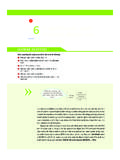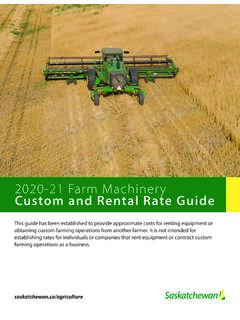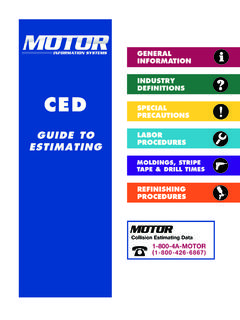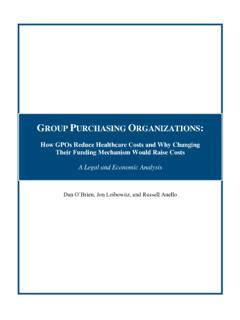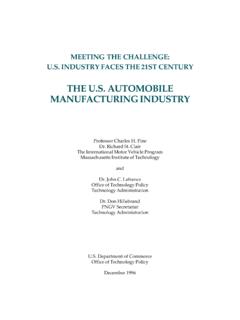Transcription of Structure of Production Costs in Footwear Manufacture
1 UNITED NATIONS INDUSTRIAL DEVELOPMENT ORGANIZATION 11 December 2000 Fourteenth Session of the LEATHER AND LEATHER PRODUCTS INDUSTRY PANEL Zlin, Czech Republic 13-15 December 2000 Structure OF Production Costs IN Footwear Manufacture Prepared by Ferenc Schm l UNIDO Secretariat *This document has been prepared without formal editing. 2 Production Costs in Footwear Manufacture 14th Meeting of the UNIDO Leather Panel TABLE OF CONTENTS INTRODUCTION .. 3 PRINCIPLES OF 4 4 Costing 5 Material 7 Labour 8 SURVEY OF Production Costs .. 9 Basic assumptions .. 9 Shoe specification .. 9 Costing 10 ANALYSIS OF Production Costs IN SELECTED COUNTRIES .. 11 Database .. 11 Material 11 Labour Costs .. 13 Production cost 15 Prices.
2 16 COSTING 17 Data acquisition for costing .. 17 Costing computation .. 17 23 References .. 24 Annexes 1. Text of the request for costing information. 2. Numeric information collected on Footwear costing. 3. Sample costing reports produced by a computer program. 3 Production Costs in Footwear Manufacture 14th Meeting of the UNIDO Leather Panel INTRODUCTION Representatives of the leather-based industry especially those involved in the leather products ( Footwear , leather goods, gloves, leather garment and sports goods) sub-sectors have been quoting Production (especially labour) Costs as the main or the only reason for shifting these manufacturing capacities from industrialized to developing countries (or in other words: from North and West to South and East) during the past three decades.
3 However only unreliable statistics on (industrial) wages paid to direct (manual) workers in various countries or regions of the world or statements made by businessmen and managers of multinational companies were available to support this reasoning. At the same time the world-wide development of the leather and its derived products manufacturing industry shows several instances contradicting this assumption: it is sufficient to mention Italy, South Korea and Portugal as counter examples. The main objective of this survey is two fold: to clarify actual differences in direct manufacturing Costs of Footwear Production in selected countries and to review the proportion of different cost components/structures in the case of comparable labour intensive products such as Footwear and/or its upper.
4 As styles vary considerably (mainly due to fashion and market demands) and systems of costing used in different parts of the world are far from being uniform, a common scheme of costing had to be established. This was based on more or less standard types of shoe styles and on a suggested, simple cost computation algorithm. In 1999 UNIDO relying on its contacts established through previous technical assistance projects, the Leather-based Industry Panel and personal contact approached organizations (companies, associations and institutes) in 42 countries to seek their assistance in collecting information on cost components and/or actual costing sheets characteristic for or representing the local shoe industry. Finally data were received from the following 12 countries: Costa Rica, Czech Republic, Egypt, France, Hungary, India, Italy, Kenya, Mexico, the Philippines, Turkey, Ukraine and Zimbabwe.
5 (According to UN classifications this corresponds to 2 industrialized, 3 transitional and 7 developing countries. The geographical distribution: Africa 3, Asia 2, Europe 5, Latin America 2.) Although in a strict statistical sense the limited number of data voluntarily submitted cannot serve as representative for the entire world, it is suitable for making some indicative conclusions regarding general trends governing the international trade of Footwear . All known (internationally active) Footwear CAD suppliers were approached and offered the opportunity to demonstrate costing-related modules of their systems through real examples. Surprisingly only three companies responded they deserve to be mentioned here: CLASSICAD SPOL. S (Czech Republic), DNT (Italy), SHOEMASTER/TORIELLI RAG.
6 PIETRO & (Italy). 4 Production Costs in Footwear Manufacture 14th Meeting of the UNIDO Leather Panel PRINCIPLES OF COSTING All (industrial) activities are associated with Costs nothing comes free in a market economy environment. Production results (products) are the result of using inputs (plants, materials, labour, knowledge and information frequently referred to as resources) and adding ideas and special features ( design, brand, quality) of the manufacturer. Terminology According to general understanding Costs are prices paid or required for acquiring, producing, or maintaining something, usually measured in money, time, or energy; expense or expenditure; outlay.[1] In industrial and economic contexts cost is a measurement, in financial terms it is the amount of scarce resources used for some purpose;[2] the amount of expenditure (actual or notional) incurred on, or attributed to, a specific thing or activity.
7 [3] Like everyday perception, these definitions mention or imply that Costs have a monetary equivalence, Costs are normally expressed in financial terms. Costs may be classified by their behavior as fixed Costs do not change with the level of Production ( rents, insurances, salaries of certain executives); variable Costs are in direct proportion to the volume of Production ( materials, wages, packaging); semi-variable Costs increase or decrease as volume of Production changes but not in direct proportion ( sales ledger).[4] In relation to products or services provided by a manufacturing company, Costs may be direct Costs can be identified with and allocated to products/units ( materials, labour charges including related social Costs , expenses such as lease of special equipment required for manufacturing certain products); indirect Costs often referred to as overheads or burdens cover materials, labour and expenses which it is either impossible or inconvenient to charge direct to the product/unit ( supervision, administration, maintenance, utilities).
8 [2] The price is the amount of money paid for products or services according to the set/agreed terms and as such is a marketing tool.[6] The selling price of a manufactured product consists of two items: its cost to the manufacturer and the manufacturer s profit.[4] Net prices do not include any taxes ( Value Added Tax VAT, sales tax) paid to governments or their agencies; gross prices include such taxes and/or handling or forwarding Costs . In the case of commodities produced by the industry and supplied to customers usually through various sale channels prices are relative to partners participating in the actual transaction. The most frequently used variants are Production or ex-factory, wholesaler, retailer, import and export (FOB, C&F, CIF, DDU etc.) prices.
9 Prices may also include services provided to the buyer or ultimate user for a given period of time ( installation, guarantee, repair and/or maintenance). Final prices and payment procedures along with delivery terms are usually agreed in negotiations with the buyer. 5 Production Costs in Footwear Manufacture 14th Meeting of the UNIDO Leather Panel Subsidy is a financial aid supplied by a government to an industry for reasons of public welfare, the balance of payments, etc.; any monetary aid, grant, or contribution.[1] Such financial support may be provided to manufacturers or traders (wholesales, distributors or retailers), but in any case it distorts free competition and, therefore, it is not compatible with market economy.
10 If the result of an economic including manufacturing venture is positive, the revenues/income surpasses expenditures ( Costs ), then profit is produced, otherwise the business produces losses. Both entrepreneurs and governments are interested in generating profit: the former to gain returns on their investments, the latter to collect (corporate) taxes. In market economy conditions, theoretically and indirectly, customers are also interested in profitability of all participants of the supply chain manufacturers and traders otherwise the given commodity would not be produced, supplied and available. The price and cost Structure has the following components: Direct material Direct wages DIRECT Direct expenses Prime Costs Factory overheads Factory Costs Administrative overheads Selling overheads INDIRECT Distribution overheads TOTAL Costs Profit NET SELLING PRICE Costing methods Costing is the function normally undertaken by administration and/or the management of manufacturing companies to identify and compute occurring Costs associated with Production and related activities.

